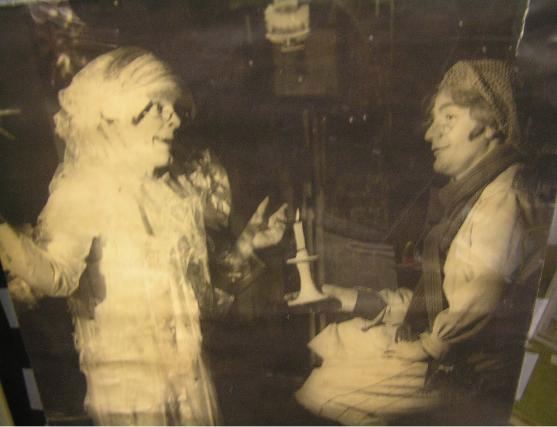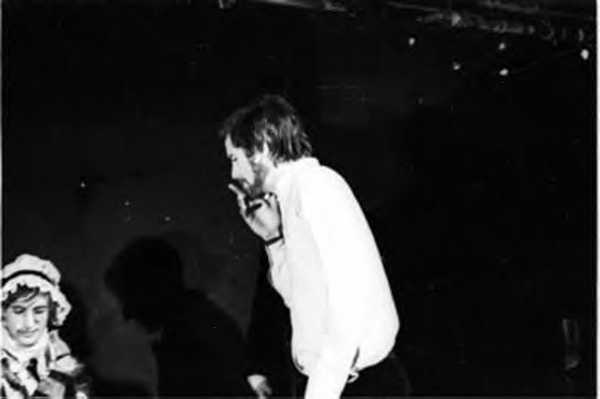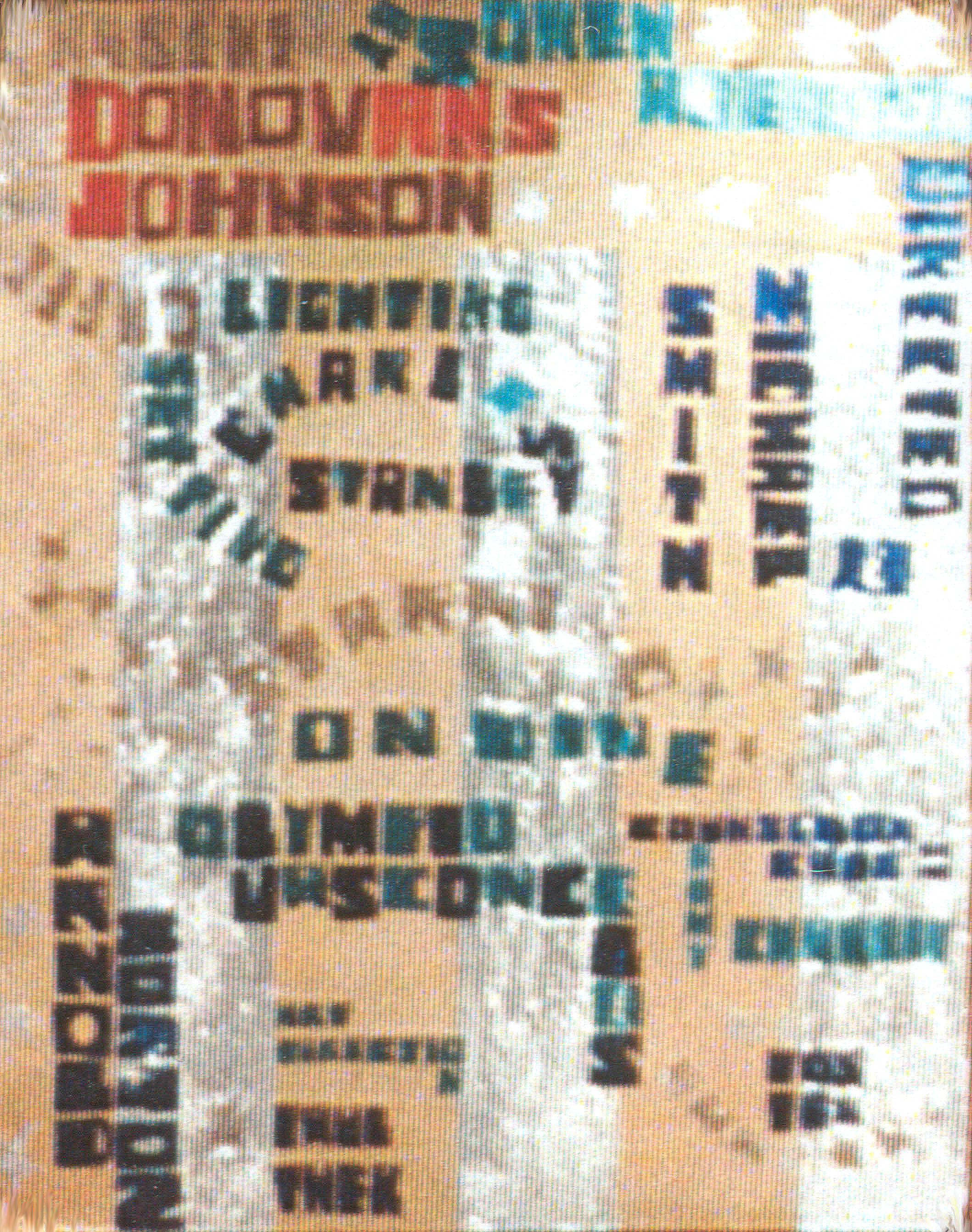Directing: Søren Agenoux
“CHAS. DICKENS’S CHRISTMAS CAROL”
Caffè Cino, New York, Christmas 1966
Søren’s play was a delirious pastiche of Walt Disney’s Scrooge McDuck comics, received impressions of the Dickens story, found language, and surrealistic amphetamine raving. I took it to be brilliant as artifact if not art, but what’s the difference? Ondine was stunning as Scrooge, his own venomous persona merging with the character’s. Charles Stanley, gaunt and saturnine, played Tiny Tim on his knees, with a half-size crutch. Soren’s boyfriend Arnold Horton brought Bob Cratchitt a lingering embattled wholesomeness, and Søren played Mrs. Cratchitt in mob cap and gingham, looking out from this getup very much his own weird self. Bob Patrick played Jacob Marley. Jaque Lynn Colton, inspired by two months in Hostelbro working with Barba, embodied the Ghost of Christmas Past, with a crown of candles burning on her head. Squeezing such a wide-ranging play into the Cino’s tiny performance zone, even with Johnny Dodd’s imaginative lighting, obviously called for something something very different from realism. At one point Cardinal Spellman took Scrooge for a helicopter tour of the Dismal Swamp : Vietnam. Not everyone could buy the feverishly cool style I came up with, but I have always felt proud of this production, which crystallized a rhapsodic if unsustainable cultural moment.
There were a lot of drugs around, principally speed in various forms, and pot, and psychedelics. Ondine was a notorious speed freak, and Søren had seduced me into relying on amphetamines, which was thrilling for a while but ultimately catastrophic. This “Christmas Carol” has been seen as the beginning of the end of the Caffè Cino: Joe Cino was increasingly undone in the following months and committed suicide in the cafe on March 30, 1967. I had brought these people to the cafe, which was the only place available to do work anything like this; indeed the availability of the cafe and Joe Cino’s welcome and support had brought the play into being. My reviews in The Voice, beginning in 1962-63 when I fell for Johnny Dodd, then the waiter, helped make the Caffè Cino such a hotbed of creativity, launching Off-Off-Broadway. So it was ironic that, as an unintended consequence of “Chas. Dickens’s Christmas Carol,” I killed Joe Cino.
The play was published in my anthology “The Best of Off-Off-Broadway” (E. P. Dutton, 1969).
Reviews
from The Village Voice, December 29, 1966
by Ross Wetzsteon
There’s something rather appealing about a pro-Scrooge interpretation of “A Christmas Carol”—most of us probably had moments during the past two weeks when we felt that Scrooge had something important to say for our times. And even a homosexual interpretation of Scrooge isn’t as preposterous as it might seem—if you read the story for double entendres (“they often ‘came down’ handsomely”) you’d be surprised… ; and the visit of “the spirit of Christmas Past” really is, in a sense, an attempted heterosexual seduction; and the idea of Scrooge’s saving Tiny Tim for, shall we say, rather dubious motives, could be effective satire of the impulse to charity.
But the trouble with Søren Agenoux’s “Chas. Dickens’ Christmas Carol” is that it includes itself in its mockery. If there’s anything worse than taking oneself too seriously, it’s taking oneself too ridiculously. For when self-mockery becomes compulsive, it isn’t mockery any more—far from attacking oneself, one is making onself invulnerable by pre-empting the right of others to judge. “You can’t call me ridiculous,” it says, “because I’ve already insisted I am.”
It seemed to me that this play compulsively undercut itself at every moment—either in the script itself or in the attitude of the actors toward the script. One character would indulge in lyric flights, another would call them nonsense. Jokes would be made, then called stupid. “Character analyses” would be offered, then called superficial. “Social commentary” would be presented, then called preposterous. Nothing was stated without its own cancellation, nothing was put forth without a complementary mockery, nothing was asserted without being simultaneously denied—so that in the end nothing was left. Every line seemed to be written with a pencil in one hand, an eraser in the other. Every speech seemed to say, “I don’t believe for a moment that this is worth saying.” In short, the play seemed to be trying to avoid judgment by becoming empty, to rise above itself by becoming nothing.
There are two ways in which this kind of approach might be justified: either because the world, as Scrooge says, is “cosmically inane,” or because the play, as the actors indicate, is just a light-hearted romp.
As for the first, “cosmic inanity” wasn’t so much an accusation as a self-justification. The point of existentialist “absurdity” is precisely that it isn’t an excuse—the point of camp’s “ridiculousness” is the perfect excuse for indulging our own. This Scrooge wasn’t distressed by “cosmic inanity,” he was positively relieved.

Donald L. Brooks as Marley’s Ghost and Ondine as Scrooge in “Chas. Dickens’s Christmas Carol” (photo: Conrad Ward)
As for the second, was it a light-hearted romp because of the shared joy in being together—or shared contempt for those not there? In a way, I suppose Scrooge is definitive camp—the outcast heaping malice on the straight world, one of the greatest put-downs in history—but even if Scrooge’s conversion is totally unconvincing, Dickens saw the self-contempt beneath Scrooge’s scornful mockery, and understood that Scrooge’s malicious cackling verged on despair. Romping with an unconverted Scrooge simply can’t be light-hearted—the disguises are too transparent—and contempot for others, in trying to become joy of self, merely transforms exclusivism into in-jokes.
At one point one of the actors read Naomi Levine’s recent letter to The Voice about her appearance in the movie “Kiss.” Only by the merest coincidence did I recognize the reference; I presume there were others I didn’t recognize. The reader who doesn’t recall the letter and who hasn’t seen the play will have some idea of the distancing mechanisms at work—a reference about a reference about something he doesn’t know anything about in the first place.
I have nothing against in-jokes on principle—but when Godard uses them, for example, he is freely offering them to whoever wants to be “in” with him in his love for movies; when this kind of play uses them, on the other hand, rather than offering it withholds, and what is “in” is not something valuable to share but something valuable precisely because it is denied to others.
Perhaps I am confusing the play with the self-cancelling aura in which it was performed—by Ondine, in particular, who was so self-consciously inept that it soon became apparent that self-conscious ineptness was his style, his comment, and, in an echo of Genet, his reaction to the world’s evaluation of him. This isn’t just to say that he clearly didn’t have the vaguest idea what a third of his lines meant, or that he had trouble simply delivering a quarter of them—but that he only seemed interested in the performance when he could mock either the play or himself as an actor. His high points were his break-ups, his ad libs, asides, and winks, which far from being spontaneous seemed inevitable.
But if the break-ups are the high points, we’re supposed to enjoy the attitude toward the play more than the play itself. But if the attitude is to mock the very thing one is doing, and even the way in which one is mocking it, we’re left with nothing to enjoy but empty mockery. Unrelieved facetiousness is like a parody of the void, a caricature of a vacuum.
My objection to Ondine as an actor, in short, was that he refused to allow himself to be responded to as an actor—or even as a person, for that matter, for the persona became a kind of permanent makeup, its function not only to beautify but to conceal.
If I’ve said almost nothing about the play itself, it’s not so much because it didn’t deserve evaluation as that, like Ondine, it didn’t even allow it. Its primary impetus was toward untouchability. If it didn’t believe in itself for a moment (in Truffaut’s sense of “sincerity”), if its leading actor appeared in it only to mock it, why should we care?—which was precisely its point. For if we don’t care, it’s invulnerable to our judgment; and if it doesn’t care about itself, it’s unvulnerable to its own self-contempt.
Since it was Christmas Eve, and I wanted to get back into a more seasonal mood, I went home and re-read “A Christmas Carol.” Here’s an interesting passage: “You fear the world too much… All your other hopes have merged into the hope of being beyond the chance of its sordid reproach.”
Copyright © 1966, The Village Voice
“DONOVAN’S JOHNSON’
Caffè Cino, New York, April 1967
I directed Søren’s second play a month after Joe Cino’s death, which had traumatized me and everyone around me. Joe Cino’s suicide seemed to be a repudiation of the values he had lived by and transmitted to the new wave of theatre artists who had emerged under his patronage. If his big-hearted, exuberant embrace of life and people in all their variety had gone so sour, where did that leave us? Who else was there to tell us, “Do what you have to do”?
I did not know what a “johnson” was—prison slang for dick, Søren said. Why Donovan? I don’t know, except Søren liked Donovan: we had played “Mellow Yellow” for the opening cue in “Christmas Carol.”
Here is my account of the production of “Donovan’s Johnson” from my unpublished memoir, “When I Was Gay”.
Charles Stanley and a few other stalwarts hung in and kept the Caffé Cino going, and I still had the date Joe Cino had given me to direct Søren’s new play, “Donovan’s Johnson.” I started rehearsing it just as Johnny left for Europe for a months-long tour lighting “Black New World.” Ondine and a demented Brazilian queen played two criminal types making their way back to the city after a spell at Sing Sing; Søren’s handsome, sweet boyfriend, Arnold Horton, was a small-town boy who tried to help them…. The dialogue for the middle of three scenes was stage directions from Verdi’s “La Forza del Destino,” an abstract conversation during which the two principals swept up and down the center aisle of the café with brooms, playing bowls in blue-green and lavender moonlight with imaginary balls to a soundtrack I taped myself, according to the stage directions: the first minute of the “Moonlight” Sonata, a stumble, a mistake, then starting over, again and again. It was extraordinarily strange and beautiful.
“Donovan’s Johnson” turned into a notable fiasco. Ondine was shooting speed in the dressing room. Olimpio was dosing himself with obatrol and/or biphetamine, which made his energy and timing come and go in waves, alternating bursts of dazzling beauty, grace, and wit and empty, dazed longueurs laid arbitrarily over Søren’s already barely comprehensible script. I cannot believe, in retrospect, what inner confusion I put up with, how fearlessly and foolishly I embraced this bottomless ambiguity—Negative Capability carried too far!
Søren was suffering personal, romantic madness, too, Arnold determined to pull away, leave the city, and go back to his own probably not so innocent small-town life, like the character in the play. So Søren was having his heart broken at the same time his play was falling apart. We were crazed on speed. We never slept. We would keep going for three or four days, crash, eat a meal, and take off again.
“Donovan’s Johnson” concluded with the wordless presentation of a mysterious object meant to signify the electric chair. This doom-laden symbol had to be non-literal but something, and what Søren came up with was a valuable sculpture on loan from the artist, Paul Thek—a pyramid of glass eighteen inches high enclosing a dayglo red lump with wires rising out of it surmounted by tiny dayglo yellow disks. This inscrutably baleful sculpture was brought out at the end of the final scene by a workman in overalls who showed it to the audience very briefly before taking it away again, leaving everyone wondering, “What was that?”
We staggered through a week of performances, the dwindling audiences as disoriented as the actors. When Arnold left town, Gerard Malanga read the role from the sidelines and then started playing it. Olimpio refused to rehearse. Søren was in despair. The play was dying, and at the end of the first week of the planned two-week run, Charles intervened to put it out of its misery. Just before the sculpture was whisked off, Charles appeared with a hammer and smashed it. That was the end of “Donovan’s Johnson.”
Søren is no longer with us: R.I.P. I have a partial script of “Donovan’s Johnson,” but the last pages of the play are regrettably lost.
“DONOVAN’S BRAIN”
Søren was a dear friend of mine and I believed in his writing. I ran his review of John Rechy’s “City of Night” in The Voice, but it was at the outer edge of comprehensible discourse (that’s what I liked about it), and I couldn’t get the next one past wiser heads. The plays got too crazy even for me. The hallucinatory dementedness of “Christmas Carol” had suited the times to a T. I went along with “Donovan’s Johnson,” despite incomprehensible stage directions and a general pointlessness, because I loved Ondine and the dreaminess of the second scene. The production was a nightmare. I couldn’t stand Søren’s next play, “Donovan’s Brain,” which he wrote for me to direct at Judson, and I couldn’t see myself doing it: directing a play is months out of one’s life, an all-consuming commitment of hard work. He was terribly disappointed, I think, and so far as I know, the play was never done. I have a partial script and will propagate it when I have a chance. It is as dense as Tavel—beyond me, possibly some kind of masterwork.


